A.C CIRCUIT CONTAINING CAPACITANCE ONLY
When an alternating voltage is applied to a capacitor, the capacitor is charged first in one direction and then in the opposite direction.
The result is that electrons move to and fro round the circuit connecting the plates, thus constituting alternating current.
Consider a capacitor of capacitance C connected across an alternating source of e .m. f .
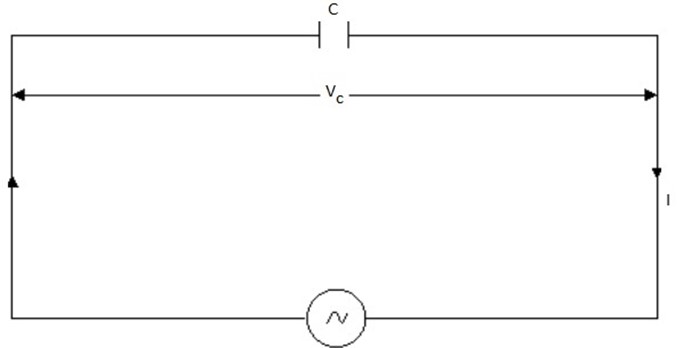
Suppose the instantaneous value of the alternating e.m.f E is given by
E =  sin ωt …….. (i)
sin ωt …….. (i)
If I is the current in the circuit and Q is the charge on the capacitor at this instant, then the Potential difference across the capacitor VC

At every instant the applied e.m.f E must be equal to the potential difference across the capacitor.
E =

Q = C sin ωt
sin ωt
From,
I = 
I =
I = Cω cos ωt
cos ωt
I = Cω  sin (ωt +
sin (ωt + 2
2

The value of I0 will be maximum Io when sin (wt+ ) = 1
) = 1

Substituting the value of Io in equation (ii)

1) Phase Angle
It is clear from equation (I) and (ii) that circuit current leads the applied voltage by π/2 radians or 90Ëš.
This fact is also indicated in the wave diagram.
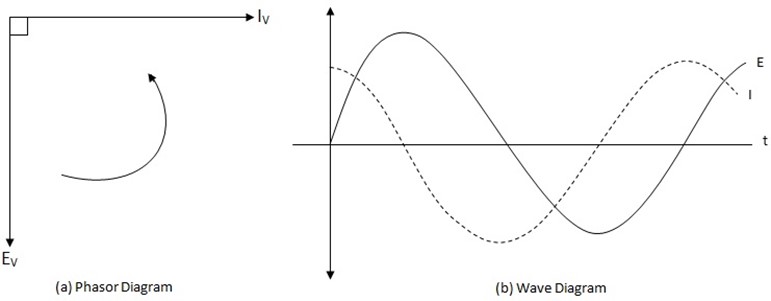
It also reveals that Iv leads Ev by 90°, hence in a.c circuit current in capacity leads the voltage.
This means that when voltage across capacitor is zero, current in capacitor is maximum and vice versa.
When P.d across capacitor is maximum , the capacitor is fully charged, i.e circuit current is zero.
, the capacitor is fully charged, i.e circuit current is zero.
Since the rate at which a sinusoidally varying p.d falls is greater as it reaches zero, the current has its maximum value when P.d across capacitor is zero. Hence, current and voltage are out of phase by 90°.
CAPACITIVE RESISTANCE
Capacitive resistance is the opposition which a capacitor offers to current flow. It is denoted by XC.
Capacitance not only causes the voltage to lag behind the current but it also limits the magnitude of current in the circuit.
We have seen above that
 =
= 
 =
=
Then

Clearly, the opposition offered by capacitance to current flow is 1/ωC
The quantity 1/ωC is called capacity reactance XC of the capacitor
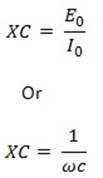
XC will be in Ω if f is in Hz and C in Farad
a) From
 =
=
Then
 =
= 

b) For d.c
f = 0
XC =  =
=
XC = 
XC = ∞
Therefore a pure capacitance offers infinite opposition to d.c. In other words, a capacitor blocks d.c.
c. From
XC =

Therefore the greater the f the smaller is XC and vice versa
d) From
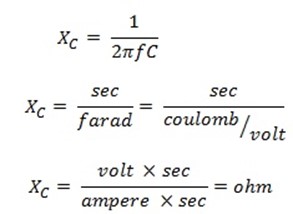
Therefore the units XC are Ohm
(iii) AVERAGE POWER ABSORBED
From
E =  sin ωt
sin ωt
I =  sin (ωt+
sin (ωt+ 2)
2)
I =  cos ωt
cos ωt
Instantaneous power P
P = EI
P =  Sin ωt.
Sin ωt.  Cos ωt
Cos ωt
P =  (sinωtcosωt)
(sinωtcosωt)
P =  Sin 2ωt
Sin 2ωt
∴ Average power P = Average of P Over one cycle
P = Sin 2ωtdt
Sin 2ωtdt
P = 0
Hence average power absorbed by pure capacitance is zero.
During one quarter cycle of the alternating source of  energy is stored in the electric field of the capacitor.
energy is stored in the electric field of the capacitor.
This energy is supplied by the source during the next quarter cycle, the stored energy is returned to the source
WORKED EXAMPLES
1. A 318μF capacitor is connected 230V, 50Hz supply. Determine
i) The capacitive reactance
ii)  r.m.s value of circuit current
r.m.s value of circuit current
iii) Equations for voltage and current
Solution
C = 318μF = 318 x 10-6 F

f = 50 Hz
i) Capacitive reactance XC
XC = 
XC = 
XC = 10 Ω
ii) r.m.s value of current 
 =
= =
=
 = 23A
= 23A
iii )
 =
= .
.
 = √2 x 23
= √2 x 23
 =
= 230
230  = 32.53A
= 32.53A
 = 325.27 V
= 325.27 V
ω= 2
ω = 2
ω= 314
E0 = 325.27sin 314t and I = 32.53 sin314t
2. A coil has an inductance of 1H
a) At what frequency will it have a reactance of 3142Ω?
b) What should be the capacitance of a condenser which has the same reactance at that frequency?
Solution
a) L = 1H
XL = 3142Ω
f = ?
XL = 2
f =  =
= :
:
f= 500Hz
b) XC = 3142 , f=500 Hz
C =?
XC =
C = 
C = 
C = 0.11

C = 0.11
3. A 50 capacitor is connected to a 230V, 50Hz supply. Determine
capacitor is connected to a 230V, 50Hz supply. Determine
i) The maximum charge on the capacitor
ii) The maximum energy stored in the capacitor
Solution
The charge and energy in capacitor will be maximum when p.d across the capacitor is maximum.
i) Maximum charge on the capacitor
Q = C
Q = C
Q = (50x ) x (230 x
) x (230 x )
)
Q = 16.26 x  C
C
ii) Maximum energy stored in the capacitor U
U =  C
C
U = 1/2 x (50x ) x (230 x
) x (230 x 
 2
2
U = 2.65J
4. The Instantaneous current in a pure inductance of 5H is given be
I = 10sin (314t-  amperes
amperes
A capacitor is connected in parallel with the inductor. What should be the capacitance of the capacitor to receive the same amount of energy as inductance at the same terminal voltage?
Solution
The current flowing through pure inductor is
I = 10 Sin (314t )
)
 = 10A
= 10A
ω = 314s-1
Maximum energy stored in the inductor
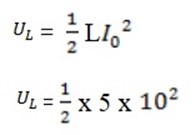
UL = 250J ………. (i)
Now
 = ωL
= ωL
= 314 x 5 x 10
 = 15700v
= 15700v
Max energy stored in the capacitor of capacitance C
 =
= 

 =
=  ……….(ii)
……….(ii)
Equate the equation (I and (ii)
and (ii)
=  = 250
= 250
C = 
C = 2.03 x  F
F
C = 2.03 